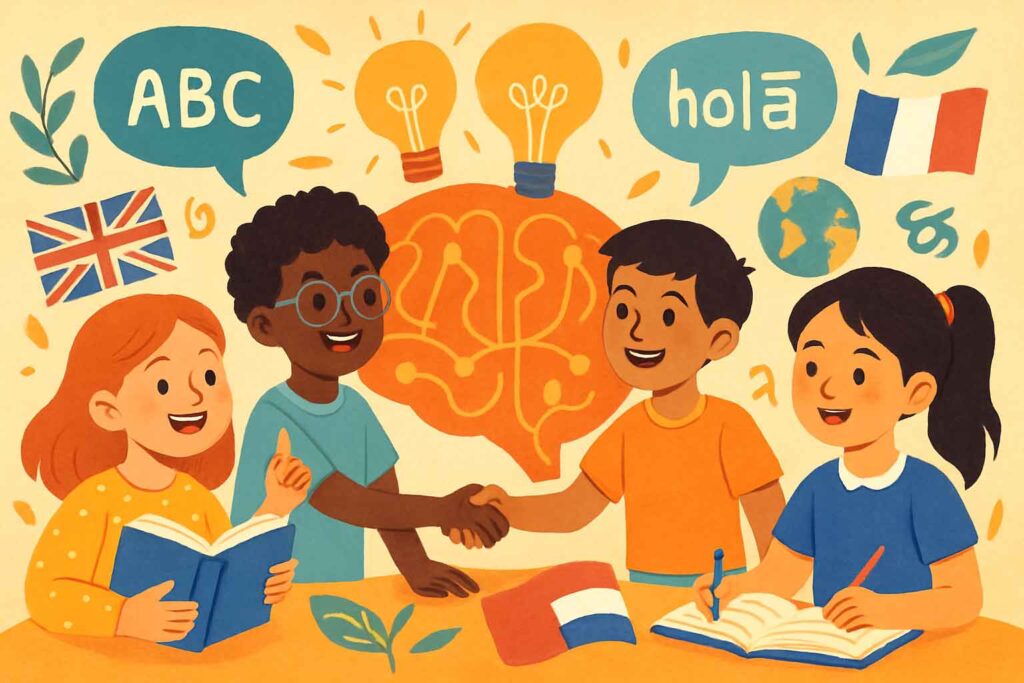Introduction
In an increasingly interconnected world, the ability to speak more than one language is becoming less of a niche skill and more of a valuable asset. Beyond simply facilitating communication across cultures, research has consistently shown that bilingualism offers a myriad of cognitive, social, and academic benefits for children, particularly when introduced during early childhood. This article will delve into the fascinating world of bilingual development, exploring why raising a bilingual child is a profound gift that can enhance their brain power, broaden their perspectives, and prepare them for a global future.
What is Bilingualism?
Bilingualism refers to the ability to use two languages with some level of proficiency. It exists on a spectrum, ranging from balanced bilinguals who are equally proficient in both languages, to dominant bilinguals who are stronger in one language than the other. Children can become bilingual through various pathways:
•Simultaneous Bilingualism: Learning two languages from birth (e.g., parents speaking different native languages).
•Sequential Bilingualism: Learning a second language after the first language has been established (e.g., starting a second language in preschool or elementary school).
It’s important to note that children do not get confused by learning two languages simultaneously; their brains are remarkably adept at distinguishing between linguistic systems.
Cognitive Benefits: A Sharper Mind
The most extensively researched area of bilingualism is its impact on cognitive development. Far from being a burden, managing two language systems appears to enhance several executive functions of the brain:
1. Enhanced Executive Functioning
Bilingual children constantly switch between languages, even subconsciously. This mental juggling acts as a continuous brain exercise, strengthening the brain’s executive functions, which include:
•Attention and Focus: Bilinguals often demonstrate a superior ability to focus on relevant information and ignore distractions.
•Problem-Solving: The constant need to select the appropriate language and inhibit the other can lead to better problem-solving skills in non-linguistic tasks.
•Task Switching: Bilingual individuals tend to be more adept at switching between different tasks or rules.
•Cognitive Flexibility: The ability to adapt to new situations and think about concepts in different ways is often heightened.
2. Metalinguistic Awareness
Bilingual children develop a deeper understanding of language itself. They are more aware of how language works, its structure, and its rules. This metalinguistic awareness can translate into better reading skills and a greater ease in learning additional languages later in life.
3. Creativity and Divergent Thinking
Some studies suggest that bilingual children exhibit greater creativity and divergent thinking, which is the ability to generate multiple solutions to a problem. This might be due to their broader linguistic and cultural exposure.
Social and Emotional Benefits: A Broader Worldview
Beyond cognitive advantages, bilingualism also enriches a child’s social and emotional landscape:
1. Cultural Connection and Identity
Speaking the language of their heritage allows children to connect more deeply with their family, culture, and traditions. It fosters a stronger sense of identity and belonging.
2. Enhanced Empathy and Perspective-Taking
Exposure to different languages often comes with exposure to different cultures. This can lead to increased empathy, as children learn to understand and appreciate diverse perspectives and ways of thinking.
3. Improved Communication Skills
Bilingual children often become more effective communicators overall. They learn to adapt their language use to different contexts and audiences, and they may be more sensitive to non-verbal cues.
4. Global Citizenship
In an increasingly globalized world, bilingualism prepares children to be true global citizens. It opens doors to international opportunities, fosters cross-cultural understanding, and equips them to navigate diverse environments.
Academic and Future Benefits
While the primary goal of bilingual education is not solely academic, there are clear advantages:
1. Academic Performance
Studies have shown that bilingual children often perform as well as, or even better than, monolingual children in various academic subjects, including reading, math, and problem-solving, particularly in later elementary and middle school years.
2. Career Opportunities
In the job market, bilingualism is a highly sought-after skill. It can open up a wider range of career opportunities in fields such as international business, diplomacy, education, healthcare, and tourism.
3. Brain Health in Later Life
Emerging research suggests that lifelong bilingualism may contribute to cognitive reserve, potentially delaying the onset of age-related cognitive decline and conditions like Alzheimer’s disease.
Practical Tips for Parents and Educators
Fostering bilingualism can be a rewarding journey. Here are some strategies:
For Parents:
•Start Early: The earlier a child is exposed to a second language, the more natural the acquisition process will be.
•Consistency is Key: Whether it’s one parent speaking one language (OPOL), or using the minority language at home, consistency helps.
•Make it Fun: Incorporate language learning into daily activities through songs, stories, games, and play.
•Provide Exposure: Utilize books, movies, music, and interactions with native speakers.
•Be Patient: Language acquisition takes time. Celebrate small victories and avoid pressuring your child.
•Connect with Community: Join bilingual playgroups or cultural events to provide authentic language experiences.
For Educators:
•Create Immersive Environments: Use the target language as much as possible in the classroom.
•Integrate Language into All Subjects: Teach math, science, and social studies in the second language.
•Utilize Visuals and Gestures: Support understanding with non-verbal cues.
•Encourage Peer Interaction: Facilitate opportunities for bilingual children to interact and support each other.
•Celebrate Diversity: Acknowledge and celebrate the linguistic and cultural backgrounds of all students.
•Collaborate with Parents: Work with families to support language development at home.
Conclusion
Bilingualism is a superpower that equips children with a unique set of cognitive, social, and academic advantages. By embracing and nurturing a child’s ability to speak more than one language, parents and educators are not just teaching words; they are opening up new worlds, fostering deeper connections, and building more flexible, resilient, and globally-minded individuals. The bilingual advantage is clear: it’s an investment in a child’s future that pays dividends for a lifetime.
